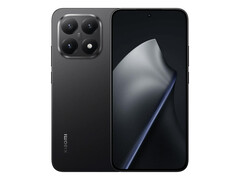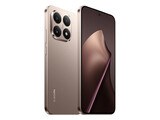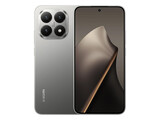Pro
Contra
El Xiaomi 15T es un smartphone de gama media que ofrece mejoras incrementales respecto al 14T, como una pantalla más grande de 6,83 pulgadas a 120 Hz, el chipset MediaTek Dimensity 8400 y 12 GB de RAM. Los críticos destacan el buen rendimiento de su cámara, la sólida duración de su batería y sus características de buque insignia a un precio competitivo de 700 euros. El rendimiento en el día a día y los juegos ligeros se manejan bien con el Dimensity 8400 y la GPU Mali-G720 MP7. Las persistentes irritaciones del software y la falta de una nueva característica definitoria son las principales críticas. Las comparaciones sitúan al Pixel 9a por delante en cuanto a cámara y experiencia de software y al iPhone 16e por delante en cuanto a potencia bruta, dejando al 15T apretujado entre esas alternativas. En general, el 15T es un teléfono competente y orientado al valor, pero no una actualización de compra obligada para los propietarios del 14T.
Especificaciones de Portátil(es)
Cámara secundaria: 32 MPix (f/2.2, FF, Videos @2160p/30fps)
Price comparison
Promedio de 6 puntuaciones (de 8 análisis)
Análisis para el Xiaomi 15T
Si está buscando un teléfono económico con un aspecto moderno y una gran relación calidad-precio, el Xiaomi 15T debería estar definitivamente en su radar. Gracias a la bajada de precio, el teléfono de gama media con sus sólidas prestaciones es casi una ganga si las características premium no son un factor a tener en cuenta en una compra.
Origen: Expert Reviews
 EN→ES
EN→ESPutting aside the software irritations, the Xiaomi 15T doesn’t actively do much wrong. It’s just that it’s not much of an upgrade over its predecessor. The display is bigger, the battery capacity is slightly higher, and we have a new processor, but otherwise, there’s nothing to set it apart from the Xiaomi 14T. Moreover, while it performs well enough, it lacks a key selling point that makes it worth picking over similarly priced rivals. The Google Pixel 9a is still the best choice for cameras, software and battery life, while the iPhone 16e is the way to go if you want the most power you can get for your money. Sitting between these two titans, the Xiaomi 15T struggles to stand out in any meaningful way. It’s a solid enough smartphone, but I can’t see a situation in which I’d recommend that you buy it over either the Pixel 9a or the iPhone 16e.
Único Análisis, disponible online, largo, Fecha: 09/26/2025
Puntuación: Puntuación total: 60%
Origen: CG Mag Online
 EN→ES
EN→ESSo with all this said, is the 15T worth the upgrade? If you are still happily carrying last year’s 14T and are satisfied with its performance, I cannot say that it is worth the upgrade. The 14T is a solid phone, and while the 15T offers a few notable updates, notably improved performance, I still cannot see the need to upgrade. However, if you are using anything older or looking for a phone that offers some of the best on-board cameras I’ve ever seen on a smartphone, I think the 15T will be a phone that impresses and meets your needs exceptionally well. The Xiaomi 15T is a solid entry in the T lineup. It offers some good, albeit incremental, upgrades to its predecessor. A better processor, larger screen, and more battery all help elevate the 15T, while its excellent camera system and overall design work together to make Xiaomi’s latest offering worth considering. A solid entry to the T lineup, the 15T is a great phone, though it does struggle to stand out against its predecessor in a meaningful way.
Único Análisis, disponible online, largo, Fecha: 09/24/2025
Puntuación: Puntuación total: 80%
Origen: Tech Advisor
 EN→ES
EN→ESLike previous entries in Xiaomi’s T-series, the 15T gives you a flagship-like experience at a bargain price. It’s a great all-rounder, no matter whether you’re looking for style, camera quality, performance or battery life. Sadly, while the Pro has received some more substantial upgrades, the base 15T feels a lot like its predecessor, and that makes it hard to get excited about. It’s a very good phone, but it doesn’t have quite the same draw as its Pro sibling.
Único Análisis, disponible online, largo, Fecha: 09/24/2025
Puntuación: Puntuación total: 80%
Origen: Computerbild
 DE→ES
DE→ESÚnico Análisis, disponible online, largo, Fecha: 10/01/2025
Puntuación: Puntuación total: 97%
Origen: Multiplayer IT
 IT→ES
IT→ESÚnico Análisis, disponible online, Muy largo, Fecha: 10/02/2025
Puntuación: Puntuación total: 75%
Origen: Cellulare Magazine
 IT→ES
IT→ESComparación, disponible online, Muy corto, Fecha: 09/24/2025
Origen: Want.nl
 NL→ES
NL→ESÚnico Análisis, disponible online, Muy corto, Fecha: 09/24/2025
Origen: Dailyweb PL
 PL→ES
PL→ESÚnico Análisis, disponible online, Mediano, Fecha: 10/01/2025
Comentario
ARM Mali-G720 MP7: Chip gráfico de gama alta para smartphones con 7 de los 16 núcleos posibles. Basado en la nueva arquitectura "5th Gen" (sucesora de Valhall) que incluye Variable Rate Shading (VRS) y Ray Racing. En comparación con el G715, debería ser posible un rendimiento un 15% superior a las mismas velocidades de reloj.
Estas tarjetas también deben ser capaces de aguantar todos los juegos actuales, pero la mayoría de ellos en configuraciones de detalles medios y bajos y con bajas resoluciones. Juegos más antiguos, o menos exigentes todavía pueden ser jugados con buena calidad de gráficos.
>> Más información puede ser encontrada en nuestra comparación de tarjetas gráficas moviles y la lista de benchmarks.
Dimensity 8400: El MediaTek Dimensity 8400 funciona con ocho núcleos ARM Cortex-A725 basados en un "diseño all-big-core" que se basa por completo en núcleos de rendimiento. Un núcleo ARM Cortex-A725 funciona a 3,25 GHz, otros tres a 3,0 GHz, mientras que los cuatro núcleos restantes sirven como núcleos de rendimiento de bajo consumo y funcionan hasta a 2,1 GHz.
>> Más información puede ser encontrada en nuestra comparación de procesadores móviles.
Top 10 Análisis
» Top 10 Portátiles Multimedia
» Top 10 Portátiles de Juego
» Top 10 Portátiles de Juego ligeros
» Top 10 Portátiles Asequibles de Oficina/Empresa
» Top 10 Portátiles de Juego Ligeros
» Top 10 Portátiles de Oficina/Empresa Premium
» Top 10 Estaciones de Trabajo
» Top 10 Subportátiles
» Top 10 Ultrabooks
» Top 10 Convertibles
» Top 10 Tablets
» Top 10 Tablets Windows
» Top 10 Tablets de menos de 250 Euros
» Top 10 Phablets (>5.5")
» Top 10 Smartphones
» Top 10 Smartphones (≤5")
» Top 10 Smartphones de menos de 300 Euros
» Top 10 Smartphones de menos de 120 Euros
» Top 10 Portátiles de menos de 1000 Euros
» Top 10 Portátiles de menos de 500 Euros
» Top 10 Portátiles de menos de 300 Euros
» Los Mejores Displays de Portátiles Analizados por Notebookcheck
Portátiles similares de otros fabricantes y con otro CPU
Portátiles con el Mismo Tamaño de Pantalla y Peso
Portátiles del mismo fabricante






